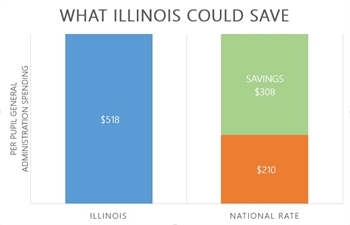
Flickr user Noah Vaughn (CC)
The shuttered Helen J. McCorkle Elementary School on Chicago's south side.
 By Quentin Shipley-Mellon
By Quentin Shipley-Mellon - April 4, 2017
Last month, the Illinois School Funding Reform Commission issued a report stating that the state would need to spend at least an additional $3.5 billion over the next decade for all school districts to reach adequate funding levels.
Page four of the report states: "At the time of writing this report, the amount of additional state money needed for all districts in Illinois to be at or above their adequacy target is estimated to be a minimum of $3.5 billion over the next decade."
A Metropolitan Planning Council analysis shows that Illinois school districts may already have some of the needed cash. The money just needs to be redirected.
Public education finance data from the U.S. Census Bureau shows that Illinois school districts collectively spent more than $1 billion in fiscal year 2014 for district-level administrative functions, by far the most of any state in the nation. The 2014 figures, released last summer, are the most recent provided by the census bureau.
Labeled as “general administration,” the census bureau defines this spending as “expenditure for board of education and executive administration (office of the superintendent) services.” Nearly 10.5 percent of all such spending in the nation occurs in Illinois alone, according to the census data.

Quentin Shipley-Mellon
On a per pupil basis, collectively, school districts in Illinois spent $518 per pupil for general administration—the second highest rate in the nation. However, if Illinois school districts spent at the level of the national average, about $210 per pupil, that more than $1 billion in annual general administration spending would become about $540 million. That’s a savings of more than $460 million a year.
Part of the gaudy general administration spending is due to the sheer number and structure of school districts in Illinois, according to MPC’s analysis.
There were more than 850 public school districts in Illinois, in fiscal year 2014, not including regional and special education districts. And nearly 220 of those districts served just one school. On top of that, nearly 100 high school districts covered the same geographic areas served by more than 370 elementary school districts. In those areas, residents were served by (and paid taxes for) two school districts—an elementary district and a high school district.

Jeffrey Waldo
Florida, on the other hand, had just 67 regular public school districts in fiscal year 2014, according to the census data. That’s one school district per county with all of them serving dozens of schools and covering both primary and secondary grades. Florida’s streamlined structure contributed to much lower levels of general administration spending.
In fiscal year 2014, less than 1 percent of all Florida school district spending covered general administration costs—about $78 per pupil. In contrast, about 4 percent of all Illinois school district spending that year covered general administration costs—about $518 per pupil, more than six times higher than the rate in Florida, according to the census figures.
Furthermore, a closer look at Illinois shows that districts with only one school spent 67 percent more for general administration per pupil than districts serving multiple schools. Meanwhile, elementary and high school districts spent 36 percent more and 29 percent more, respectively, for general administration per pupil than unit districts, which serve both primary and secondary grades.
Still, most Illinois school districts are just spending a lot more for general administration than their counterparts in other states. Chicago Public Schools is an example. About 2.6 percent of CPS spending—about $350 per pupil—covered general administration in fiscal year 2014, according to the census figures. That’s a modest share compared to other school districts in Illinois. Not so when compared to the public school systems in New York City and Los Angeles, where each system spent less than $100 per pupil for general administration.
The idea of consolidating school districts has been thrown around numerous times as a potential remedy for bloated education spending. In 2011, former governor Pat Quinn proposed a vast overhaul to the system by eliminating all current districts and starting over with just 300.
The school funding reform commission touched on the issue of consolidation, as well.
“Existing consolidation incentives and initiatives have been underfunded and have often focused on rural school districts rather than consolidating dual school districts into single unit districts,” the report said. “Commissioners agree that consolidation in certain areas of the state is important but that the solution to this problem should not be reached through funding formula reform.”
In an effort to provide more balance in education funding, particularly between property-rich and property-poor school districts, Governor Bruce Rauner tasked the commission last summer to consider alternatives to the state’s funding formula. Without offering any concrete suggestions, the commission recommended changing the formula and offered its report as a framework for the state legislature to consider what changes should be made.
Part of the commission’s work was driven by concerns to provide more resources to school districts serving poor children. MPC’s analysis shows that those districts may benefit even more from closer scrutiny of their general administration spending.
Not including the Chicago Public Schools, MPC’s analysis shows that Illinois school districts where at least 75 percent of the students were considered low-income spent about $650 per pupil for general administration, almost 57 percent more than the $415 per pupil spent by school districts where fewer than 25 percent of the students were low-income.
Given the level of general administration spending in Illinois, it’s clear that efforts to put more resources in classrooms across the state should not only focus on how schools are funded. They should focus on how school districts are spending their money, as well.